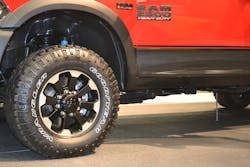University of Extrication: Pickup Truck & SUV Skills Refresher—Part 3
Topic: Pickup truck & sport utility vehicle (SUV) refresher
Objective: High ground clearance update
Task: Given a late model pickup truck and/or SUV with a high ground clearance to inspect and practice on, the rescue team will determine how to adapt their vehicle stabilization techniques accordingly.
Part 3 of our Pickup Truck & SUV Skills Refresher updates rescuers on challenges that may confront them when attempting to stabilize a crash-damaged vehicle sitting on its four wheels on a level surface. This can be a challenge because late-model pickup trucks and SUVs sit with a higher than normal ground clearance.
With passenger automobiles, rescuers are accustomed to the vehicle sitting within several inches of ground level. With a pickup truck or SUV, there is a great possibility that the vehicle sits much higher, as much as 14 to 16 inches off the ground (assuming the pickup truck owner has not installed an aftermarket lift kit on the vehicle).
The most common tool we use when stabilizing a vehicle sitting on its four wheels on a level surface is step chocks. It is very likely that a rescue crew built their own step chocks using soft pine wood blocks, glued and screwed together. If six layers of nominal 2 x 4-inch lumber were used to build these step chocks, it would mean that assembly sits only 9 inches tall. The problem: The rocker area of most pickups and SUVs today is much higher than that under normal conditions.
So what part of our stabilization tactics do we need to change? What do we need to do differently to stabilize a high ground clearance vehicle?
Truck/SUV stabilization tactics
The basic premise of this assignment is that complete stabilization of a vehicle sitting on its four wheels on a level surface should take no more than 90 seconds from start to finish. At the end of that time, the vehicle should be stable with its weight resting solidly on the cribbing placed beneath it.
The stabilization process should also follow the “chock, block, blow” process—chocking so it does not roll, blocking placed beneath the rockers to support the vehicle weight, and then blowing (deflating) the tires in order to settle the vehicle onto the cribbing below.
When stabilizing a sedan resting on its four wheels, the task can usually be completed with just four step chocks—two on each side. When the vehicle is a pickup truck or SUV with a high ground clearance, rescuers will find that four step chocks alone might not be sufficient.
Crib stacks
When assigned to stabilize a high ground clearance vehicle at a crash scene, the rescuer should grab four step chocks, but also bring along additional pieces of loose cribbing including several wedges. That way, loose cribbing can either be placed on top of each step chock or it can be used to form a box crib stack. A box crib will raise the step chock up high enough to contact the underside of the pickup or SUV.
Here’s the reality check. If just loose pieces of 4 x 4-inch cribbing were used to form each of four box crib stacks, that would total eight cribbing pieces per stack—24 pieces of loose cribbing just for total stabilization. This will take a team effort if it is to be accomplished within a reasonable amount of time. Another option is for departments to invest in commercially available step chocks specifically designed to be 16 inches or taller to better fit beneath a truck or SUV.
Training on high ground clearance vehicle stabilization can be accomplished easily using a pickup truck or SUV made available to the department. Practice gathering and placing step chocks and loose cribbing multiple times using different techniques and completed by different members. Tire deflation can be simulated if the vehicle is not to be damaged during the training.
In Part 4, we will update stabilization techniques for pickups or SUVs with a full-length running board on each side.
SIDEBAR:
Stabilization of Vehicles with High Ground Clearance
- Vehicle stabilization size-up
- Gathering of stabilization equipment
- Implement chock, block and blow stabilization tasks
- Consider step chocks with wedges or crib stacks
- Consider commercially available tall step chocks

Ron Moore
RON MOORE, who is a Firehouse contributing editor, recently retired as a division chief with the McKinney, TX, Fire Department and now serves with Prosper, TX, Fire Rescue. He self-published the Vehicle Rescue 1-2-3 training manual and serves as the forum moderator for the extrication section of Firehouse.com . Moore can be contacted directly at [email protected].






